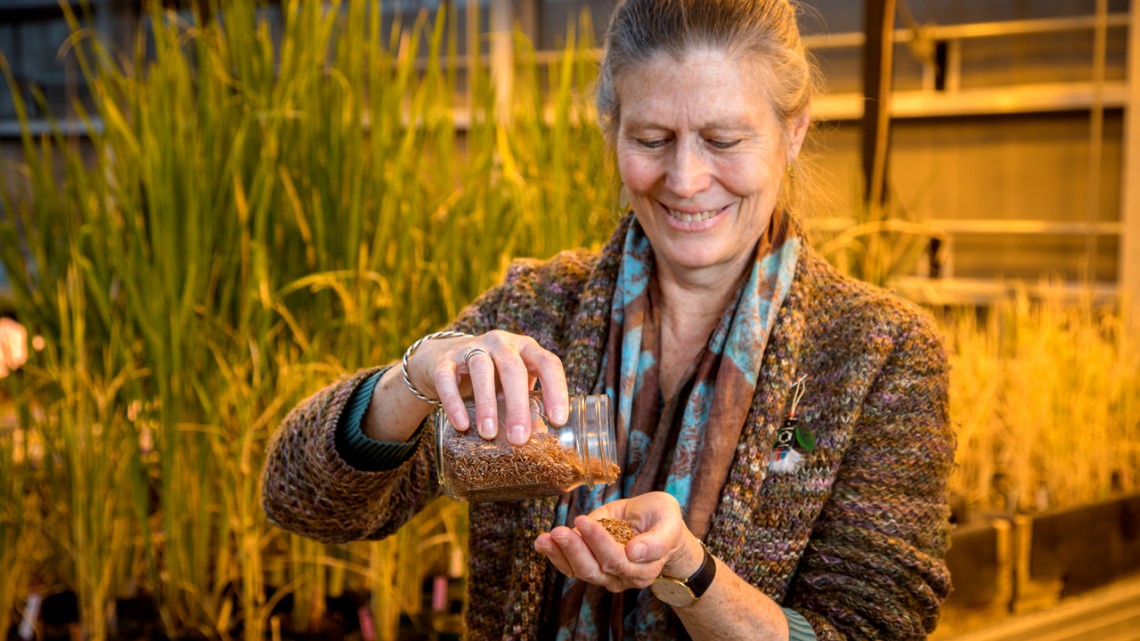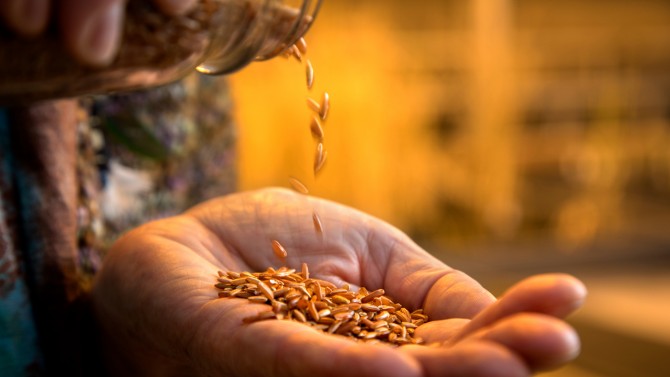
Susan McCouch, professor of plant breeding and genetics, with grains of Scarlett, a new red rice cultivar she co-developed with collaborator Anna McClung, a researcher at the USDA Agricultural Research Service.
Nutritious red rice developed for the U.S.
By Krishna Ramanujan
Researchers from Cornell and the U.S. Department of Agriculture (USDA), Agricultural Research Service announced today they are releasing a nutritious red rice cultivar that should appeal to people interested in alternative grains.
The new rice, called Scarlett, is whole-grain rice and has a nutty, rich flavor. It is also packed with nutrients: The red bran on the rice has high levels of antioxidants and flavonoids that are common in red-colored grains and fruits, along with naturally produced vitamin E.
“If people find brown rice nutritious and delicious, this rice is even better,” said Susan McCouch, professor of plant breeding and genetics, who co-developed Scarlett with collaborator Anna McClung, director and research leader at the USDA Agricultural Research Service’s Dale Bumpers National Rice Research Center in Stuttgart, Arkansas.
McCouch and her team did the back-crossing between the two parents and the genetic analysis, while McClung did the phenotypic evaluation and made the final breeding selection.
Field trials showed that Scarlett rice is high-yielding and disease-resistant, and also grows extremely well under organic conditions. It is being commercially produced and will be available to the public later this year.
“We’re working with chefs in South Carolina to come up with some new recipes that will highlight the particular culinary opportunities that the new rice presents,” McCouch said.
This is the first time a cultivated rice variety with a red pericarp, the seed’s bran layer, will be released in the United States. Most red rice in the United States is considered a “noxious weed” because the genes that lead to red pericarp are linked with such unfavorable “weedy” traits as seed dormancy and shattering (where seeds fall easily from stalks), making it hard to get rid of weedy red rice from the field. During the breeding of Scarlett, these linkages were broken, so the red pericarp in the new variety is not accompanied by any weedy characteristics.
Scarlett is a cross between an elite U.S. long-grain tropical japonica variety called “Jefferson” and a strain of Oryza rufipogon, the wild ancestor of Asian rice, collected in Malaysia.
The variety is the outcome of basic research in McCouch’s lab, investigating the genetics of wild-rice species and exploring crosses between Jefferson and strains of hardy but agronomically poor O. rufipogon. One of the offspring proved to be resilient and high-yielding while retaining its red bran.
To get rid of the weedy traits, researchers repeatedly back-crossed (bred favorable offspring with the Jefferson parent) and selected until they had a variety with long grain, high yield and disease resistance. Along with genetic testing, they ran field trials in eight locations over the last six years to ensure that no hidden wild traits would show up in different growing environments. Ming-Hsuan Chen, chemist with USDA, determined that the red grain of Scarlett was unique in that it has high levels of various anti-oxidant compounds that have been associated with health benefits in other foods.
Scarlett is adapted to subtropical climates of the southern United States, and similar to growing environments found in Uruguay and Argentina, where it may also be grown. The climates in parts of West Africa and Asia are also favorable, but the grain quality may not be preferred in those cultures, McCouch said. Due in part to the plant’s flowering time, it is not adapted to the northern United States, but McCouch and McClung may look for lineages that flower earlier and would be suitable for a northern climate.
Scarlett is being released as a public variety with no intellectual property restrictions and is royalty free.
Media Contact
Get Cornell news delivered right to your inbox.
Subscribe
